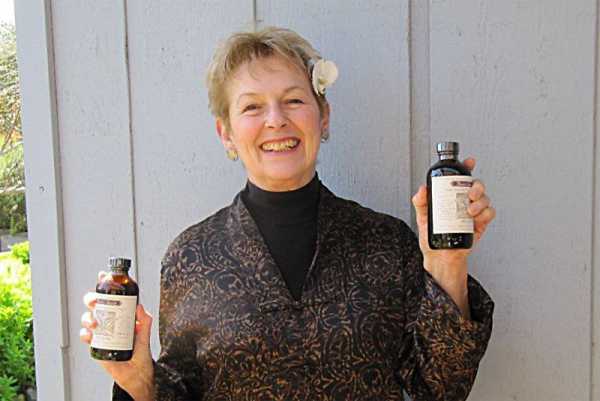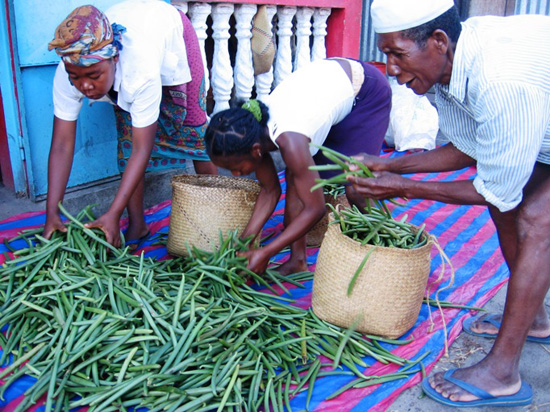
I'm amazed at how superior your vanilla is!
– Des, The Grommet
Because of the sun’s strong rays, the average annual temperature is higher and with less variance than in the more northerly and southerly latitudes. As a result, seasons in the tropics are not measured by temperature changes and cooler or warmer weather. Instead, they are defined by the trade winds drawing water from the oceans and disbursing it over the eastern coasts as seasonal rains or monsoons.
Latitude is only one of many factors that determine tropical climates. Distance from the ocean, prevailing winds and elevation are all important elements that impact the region of our planet that contains 3/4 of our world’s population.
 Tropical Rainforests provide 30% of our world’s water and oxygen.
Tropical Rainforests provide 30% of our world’s water and oxygen.
Closest to the equator are the rainforests. The lush rainforests of the Amazon and Congo basins have provided our planet with at least 30% of our world’s water and oxygen. These richly forested regions attribute their vegetation to year-round or monsoon rains and contain a remarkable diversity of flora and fauna.
In the Amazon over 1000 species of plants and animals have been identified in just one square kilometer (5/8 of a mile) of land. There are many vertical habitat layers from the high forest canopy to the densely covered floor. In addition to grasses, vines, plants and bushes, there is a great variety of tropical palms along with hardwoods interspersed throughout the forest.
As the Amazon has never experienced an ice age or prolonged drought, its plant and animal species have had time to evolve into a highly specialized matrix. We have no idea just how many species of plants and animals will become extinct due to destruction of the region and global weather change before they have even been discovered and documented.
 Given that many of the tropical rainforest plants have enormous medicinal value as well as provide a major source of our world’s water and oxygen, it is vitally important that we conserve these rich tropical forests. Sadly, both the Amazon and Congo basins are being destroyed at an alarming rate due to growing populations, deforestation, poor resource management and warfare.
Given that many of the tropical rainforest plants have enormous medicinal value as well as provide a major source of our world’s water and oxygen, it is vitally important that we conserve these rich tropical forests. Sadly, both the Amazon and Congo basins are being destroyed at an alarming rate due to growing populations, deforestation, poor resource management and warfare.
Savannahs are vast grasslands acting as a buffer between the rain forests and the drier transitional regions.
Moving further north and south of the equator are savannah and desert climates, with decreasing seasonal rainfall. The largest savannah expanses are in Africa, where much of the central part of the continent consists of grasslands. Kenya and Tanzania are two countries famous for their wildlife that roam the Serengeti plains of Africa. In the Americas, Brazil and Argentina also have vast tropical savannahs.
Savannahs depend on seasonal rainfall, with a long dry season and intense wet season. The further away from the rain forest, the dryer the region. During the wet season the lush grasses and forests that feed the wild animals and birds proliferate.
 Plants and animals living in the savannah have adapted to the long dry season. Trees, such as the baobob, store water within their trunks; others have long roots that reach to the water table. Trees such as the acacia are xerophytic, with small leaves and thorns, and can exist with minimal water. Animals migrate seasonally in search of food and water, eking out their existence by seeking water holes during the dry period.
Plants and animals living in the savannah have adapted to the long dry season. Trees, such as the baobob, store water within their trunks; others have long roots that reach to the water table. Trees such as the acacia are xerophytic, with small leaves and thorns, and can exist with minimal water. Animals migrate seasonally in search of food and water, eking out their existence by seeking water holes during the dry period.
Savannahs have delicate eco-systems that are easily damaged by human intervention. For instance, in the Serengeti, the largest savannah in Africa, tribes such as the Masai practiced nomadic farming, moving regularly to allow the savannah to replenish itself. Government restrictions forced the Masai to stay out of the Serengeti wildlife park, which precluded their nomadic existence. By remaining in one place, their cattle damaged the environment by over grazing. Commercial farming of prime savannah lands has caused even greater damage. Increased population and poaching of wild game for food has had a huge impact, all of which will lead to increased desertification in northern and central Africa.
Tropical Deserts have the highest mean annual temperatures on the planet.
Tropical deserts are found at the northern and southern edges of the tropical continents. They are caused by near-constant sub-tropical high pressure. They have the highest mean annual temperatures on the planet. This is caused by the high sun angles and the lack of clouds. Daily temperatures can exceed 120 degrees at low elevation inland deserts and many areas have consistent average monthly temperatures of over 90 degrees Fahrenheit. The highest temperature recordings in the shade have been made in the Sahara at 136.4 degrees!
 Rainfall in tropical deserts is irregular and unreliable, with an entire year’s rainfall sometimes occurring in one downpour. Continental deserts are too far from the ocean to receive any moisture. Because of this and the strong high pressure, the humidity can be less than 10%, causing evaporation of what little surface water may exist and further inhibiting precipitation. The only source of water in many tropical deserts is from oases where the ground water table is near the surface.
Rainfall in tropical deserts is irregular and unreliable, with an entire year’s rainfall sometimes occurring in one downpour. Continental deserts are too far from the ocean to receive any moisture. Because of this and the strong high pressure, the humidity can be less than 10%, causing evaporation of what little surface water may exist and further inhibiting precipitation. The only source of water in many tropical deserts is from oases where the ground water table is near the surface.
Arguably one of the driest deserts in the world is the Sahara, which stretches across much of North Africa. Saudi Arabia, Iran, Pakistan and Western India also have significant desert regions. South Africa also has deserts, most notably the Kalahari. Tropical deserts in the Americas are found in Baja California and interior Mexico as well as Argentina. Central Australia has a massive desert. Some desert regions have a variety of fauna and flora such as the Sonoran desert in Arizona and Northern Mexico; others, such as parts of the Sahara and the Grand Erg Desert of Algeria, are nearly barren.
There are also tropical deserts where cold water upwells along a coast, stabilizing the air and preventing precipitation. Coastal Chile and Peru have narrow coastal tropical deserts because of the cold Humboldt current. These deserts tend to be cool and often shrouded in fog.
 Transitional zones buffer the savannah from the harshness of the desert.
Transitional zones buffer the savannah from the harshness of the desert.
Between the deserts and the Savannah there is a transitional zone that is often used for agriculture. The Sahel in Africa is a prime example of this transition zone. The Sahel is losing ground to desertification for a number of complex reasons. While the great Saharan wind storms that often blow sands more than 160 miles, do not blow onto the farmers’ lands, the slash-and-burn lifestyle practiced worldwide by traditional farmers has left land denuded between the planting of crops. Pastoralists have cut trees and plants for their animals. The loss of perennial plants that acted to shade and protect annuals, has additionally added to loss of vegetation thereby allowing for loose soil to blow away and desertification to begin.
The National Geographic ran an article on the Sahel in April of 2008. Written by Paul Salopek, he explains that during much of the late 20th century, rising ocean temperatures altered rainfall patterns and the rains that fell to the north of the Sahel no longer came. Green lands became barren, nomads lost their herds, and the desert dunes no longer had vegetation to hold them in place. Towns and villages have been lost to desertification. Fighting for arable land is one of the factors that have fuelled the warfare of the Janjaweed against the farmers in Darfur and caused horrific violence to families and especially to women and children.
Tropical highlands contain mountains with year-round glaciers. Most of these glaciers are rapidly shrinking.
There is one more tropical zone that defies all that we think of as being tropical. The tropical highland zones of the world have a climate that is more like the temperate zones, some with seasonal variance and some with permanent snow and glaciers. However, neither seasonal change nor temperature defines tropical highlands; elevation is the key. Generally, the flat lands rising up to 3280 feet (1000 meters) are considered the hot lands. Between 3300 to 6550 feet (1000 and 2000) meters is the temperate zone. Above that lie the cold lands.
The Valley of Mexico is a highland tropical region varying between 7300 and 10,000 feet, with dry winters and warm summers. The Mexican volcano just south of Mexico City, Iztaccihuatl (Sleeping Woman) at 17,154 feet. (5239meters), has permanent snow. Even more dramatic, another Mexican volcano, Orizaba, at 18,404 feet. (5612meters), in Veracruz state has glaciers year-round. You can be in the heat of the tropics and look up at Orizaba, amazed at the expanse of white covering the top third of the mountain.
 Another dramatic example is Mount Kilimanjaro, which rises 15,100 feet (4600 meters) above the hot plains. Kilimanjaro, the tallest mountain in Africa, is known as a strato- or composite- volcano, with three volcanic peaks. Due to global weather changes, 82 percent of its ice field have been lost between 1912, when it was first mapped, and 2000. There are predictions that it could lose all of its snow by 2020; other calculations have estimated the snow will be gone by 2050.
Another dramatic example is Mount Kilimanjaro, which rises 15,100 feet (4600 meters) above the hot plains. Kilimanjaro, the tallest mountain in Africa, is known as a strato- or composite- volcano, with three volcanic peaks. Due to global weather changes, 82 percent of its ice field have been lost between 1912, when it was first mapped, and 2000. There are predictions that it could lose all of its snow by 2020; other calculations have estimated the snow will be gone by 2050.
Mount Huascaran, in Peru, at 22,200 feet is the tallest of the Cordillera Blanca, whose mountains all exceed 19,500 feet, and all of which contain glaciers and permanent snow. The Qori Kalis glacier is retreating at 60 meters a year.
Finally, the famed Mount Everest of Tibet, at 29,029 feet (8,848 meters), part of the Himalayan cordillera, is the tallest mountain in the world. Tests done in the Himalyas have shown that 67 percent of their glaciers are shrinking. There is serious concern that most of the glaciers will be gone in another forty years.
Why does it matter if the glaciers are gone?
Why does this matter? For starters, there have been significant floods in the farming and pastoral regions around these mountains, causing loss of life, property and infrastructure.
In a pretext for the United Nations declaration of 2002 as the International Year of the Mountain, it was acknowledged that 80-90% of the fresh water supply for the arid to semi-arid regions of the tropics and subtropics originates in mountainous regions, affecting more than half of humanity, principally in the developing world (Messerli, 2001). The loss of this water threatens hydroelectric power production, crop irrigation and municipal water supplies. Without hydroelectric power, fossil fuels will be used to meet power needs, adding further damage to the atmosphere.
Saving the tropics is up to us.
Given that the eco-systems of the tropics are fragile, that 75% of our world’s population live there, that over 30 percent of our water and oxygen are created there and that so many foods, flavors and other ingredients we all depend upon are grown there, the tropical zones of the world are crucial to the survival of our planet. Given their fragility, the health and poverty issues and the political instability of so many of the tropical countries, it can be very discouraging to consider the implications for us all if these regions continue to be destroyed.
However, we have a choice. We can choose to think of the tropics only as gorgeous beaches to lounge on during our vacations and remain in denial about the rest, or we can take a deep breath and get to work. If you feel as I do, that we must take action, here’s what we can do:
Get Educated. The Internet offers great opportunities for learning about the issues we all face with global weather change and its impact. Choose a program that you feel best represents your concerns. It may be coral reefs, sustainable agriculture or conservation. Perhaps you are concerned about educational programs for children or communities. Maybe it’s health issues or perhaps artisan collectives that will generate revenue streams for communities.
Get involved. Join a group that is making a difference in the area you support. Sign petitions or go to www.thepetitionsite.com and create one. They have the infrastructure for you to do this. Join or create a volunteer program. Spend a working vacation with a university or non-profit organization’s project that speaks to you. Join Americorps or the Peace Corps. Don’t have time? Make tax-deductible donations. Support a child’s education. Hold a fundraiser. Each of us can find some way to bring about positive change.
Here are a few of the many organizations working to protect the people, the environment and the economies of the tropics are listed here. For more groups, go online and Google the type of group you would like to be involved with.
Environmental groups making a difference:
Nature Conservancy (working to protect coral reefs): www.nature.org/
World Wildlife Foundation (focusing on global conservation priorities): www.panda.org/
Don’t Almost Give: www.dontalmostgive.org/
Green Peace: www.greenpeace.org/
Working to protect tropical forests:
Wiser Earth: www.wiserearth.org/
Africa Guide: www.africaguide.com
Care2: www.care2.com
Educational programs: www.tropicsfoundation.org
I was given a small bottle of Rain’s Choice in a gift basket and I have been hooked ever since. The flavor makes all of my baking so much better! I will never use grocery store vanilla again!


© 2021. All Rights Reserved
Designed/Developed by Kat & Mouse